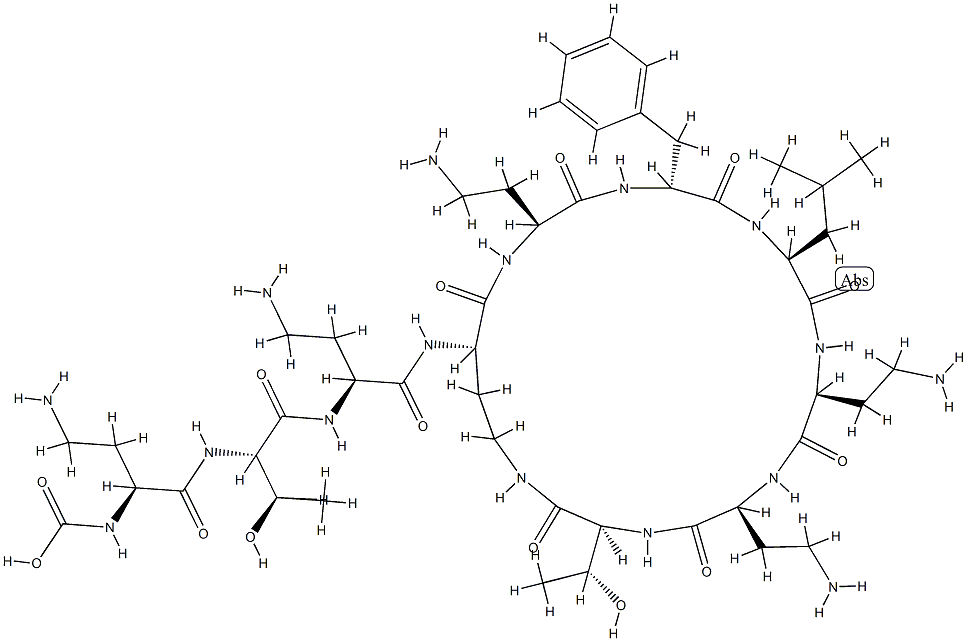Polymixin-B-Sulfate
- CAS NO.:1406-11-7
- Empirical Formula: C48H82N16O14
- Molecular Weight: 1107.26348
- MDL number: MFCD01775371
- SAFETY DATA SHEET (SDS)

What is Polymixin-B-Sulfate?
Chemical properties
All are basic polypeptides. Soluble in water; the hydrochlorides are soluble in water and methanol, insoluble in ether, acetone, chlorinated solvents, and hydrocarbons. Permissible food additives.
Originator
Aerosporin, Burroughs-Wellcome, US,1951
The Uses of Polymixin-B-Sulfate
Medicine (antibiotic), beer production.
Definition
Generic term for a series of antibiotic substances produced by strains of Bacillus polymyxa. Various polymyxins are differentiated by the letters A, B, C, D, and E. All are active against certain gram-negative bacteria. Polymyxin B is most used.
Manufacturing Process
As described in US Patent 2,595,605, in a pilot plant tank 225 liters of a medium containing the following ingredients was prepared: 2% ammonium sulfate, 0.2% potassium dihydrogen phosphate, 0.05% magnesium sulfateheptahydrate, 0.005% sodium chloride, 0.001% ferrous sulfate heptahydrate, 0.5% yeast extract, 1% dextrose, 1% calcium carbonate and 3% corn meal. The fermentation medium was adjusted to pH 7.3 to 7.4. It was then sterilized for 30 minutes at 110°C. After sterilization the pH was about 7. To the medium was added 225 ml of mineral oil.
The fermentation medium was inoculated with Bacillus polymyxa prepared as follows: A culture of Bacillus polymyxa in a tube with Trypticase soybean broth was incubated overnight at 25°C. 5 ml of this culture was transferred to 100 ml of the tank medium in a 500 ml Erlenmeyer flask which was incubated for 48 hours at room temperature. This 100 ml culture served as inoculum for one tank. During the course of fermentation the medium was aerated at the rate of 0.3 volume of air per volume of mash per minute. The temperature was maintained at about 27°C. Samples of mash were taken every 8 hours in order to determine pH and the presence of contaminants and spores. After 88 hours of fermentation the pH was about 6.3 and an assay using Escherichia coli showed the presence of 1,200 units of polymyxin per cubic centimeter. The polymyxin was extracted and purified by removing the mycelia, adsorbing the active principle on charcoal and eluting with acidic methanol.
Polymyxin is usually used as the sulfate.
Therapeutic Function
Antibacterial
Contact allergens
Polymyxin, CAS Registry Number, is a polypeptidic antibiotic complex (Polymyxin A to E) produced by Bacillus polymyxa. Polymyxin E is known as Colistin.
Safety Profile
Poison by intraperitoneal, subcutaneous, and intravenous routes. An adQtive permitted in food for human consumption.
Properties of Polymixin-B-Sulfate
| Melting point: | >300 °C |
| alpha | D23 -40° (c = 1.05) |
| CAS DataBase Reference | 1406-11-7 |
| EPA Substance Registry System | Polymyxin (1406-11-7) |
Safety information for Polymixin-B-Sulfate
Computed Descriptors for Polymixin-B-Sulfate
New Products
4-AMINO-TETRAHYDRO-PYRAN-4-CARBOXYLIC ACID HCL 4-(Dimethylamino)tetrahydro-2H-pyran-4-carbonitrile 4-Aminotetrahydropyran-4-carbonitrile Hydrochloride (R)-3-Aminobutanenitrile Hydrochloride 3-((Dimethylamino)methyl)-5-methylhexan-2-one oxalate 1,4-Dioxa-8-azaspiro[4.5]decane 5-Bromo-2-nitropyridine Nimesulide BP Aceclofenac IP/BP/EP Diclofenac Sodium IP/BP/EP/USP Mefenamic Acid IP/BP/EP/USP Ornidazole IP Diclofenac Potassium THOMAIND PAPER PH 2.0 TO 4.5 1 BOX BUFFER CAPSULE PH 9.2 - 10 CAP SODIUM CHLORIDE 0.1N CVS ALLOXAN MONOHYDRATE 98% PLATINUM 0.5% ON 3 MM ALUMINA PELLETS (TYPE 73) LITHIUM AAS SOLUTION 2-Bromo-1-(bromomethyl)-3-chloro-5-nitrobenzene 2-Bromo-3-nitroaniline N-(3-Hydroxypropyl)-N-methylacetamide 3-Bromo-6-chloropyridazine 4-ethyl-3-nitrobenzoic acidYou may like
-
 1-Methyl-6-oxo-1,6-dihydropyridazine-3-carbonitrile 98%View Details
1-Methyl-6-oxo-1,6-dihydropyridazine-3-carbonitrile 98%View Details
99903-60-3 -
 88491-46-7 98%View Details
88491-46-7 98%View Details
88491-46-7 -
 1823368-42-8 98%View Details
1823368-42-8 98%View Details
1823368-42-8 -
 2-(3-(tert-butyl)phenoxy)-2-methylpropanoic acid 1307449-08-6 98%View Details
2-(3-(tert-butyl)phenoxy)-2-methylpropanoic acid 1307449-08-6 98%View Details
1307449-08-6 -
 Ethyl 3-(furan-2-yl)-3-hydroxypropanoate 25408-95-1 98%View Details
Ethyl 3-(furan-2-yl)-3-hydroxypropanoate 25408-95-1 98%View Details
25408-95-1 -
 2-Chloro-5-fluoro-1-methoxy-3-methylbenzene 98%View Details
2-Chloro-5-fluoro-1-methoxy-3-methylbenzene 98%View Details
1805639-70-6 -
 1784294-80-9 98%View Details
1784294-80-9 98%View Details
1784294-80-9 -
 Lithium ClavulanateView Details
Lithium ClavulanateView Details
61177-44-4